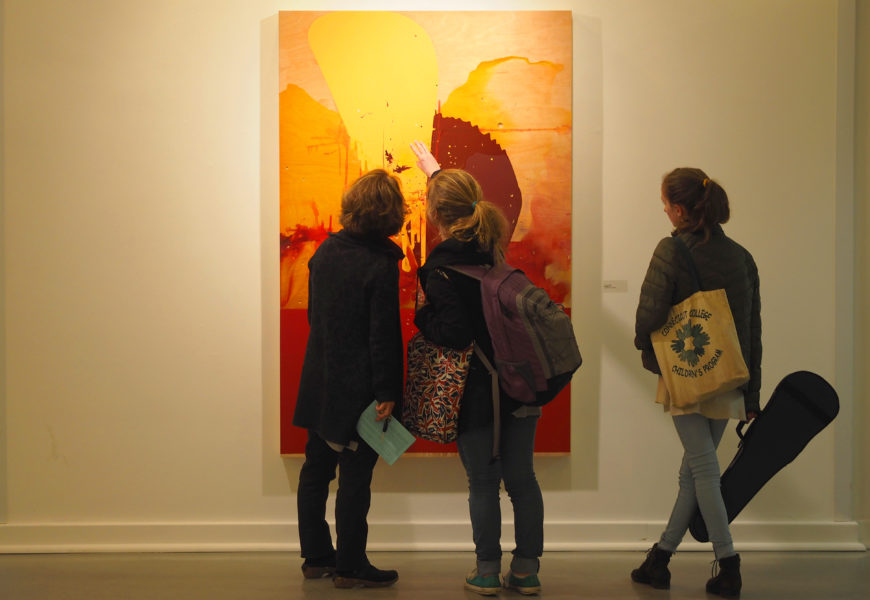Photo courtesy of Sophia Angele-Kuehn.
Ivan Toth Depeña’s ability to seamlessly incorporate the environment, technology and storytelling into his artistic creations was made clear during the lecture he gave to a packed room of students on Feb. 22 in Cummings.
Studio art produced by Depeña, a Miami and Charlotte-based artist holding a Master’s Degree in Architecture from Harvard University, was showcased in Cummings through March 3. The main focus of Depeña’s lecture, however, was not his displayed studio art but rather his public art projects and the interconnections made behind their design.
The lecture started with an introduction by Assistant Professor of Art Pamela Marks, who credited the Weissmann Visiting Artist Program for Depeña’s visit. She summed up the artist’s background and achievements, which include being awarded the prestigious Knight Arts Challenge Miami Grant for his augmented reality public art projects throughout Miami.
“If you’re not familiar with [augmented reality], it’s essentially what Pokémon Go is,” explained Depeña with a smile. The project, called “Lapse,” involves real murals and sites dispersed throughout Southern Florida, but an app found at www.lapsemiami.com overlays the real scene before the user with artistic technology and supplements it with sounds. For example, if a “Lapse” user were to ride Miami’s downtown MetroMover, a musical composition based on GPS location would accompany them. The music from the app should “build and build and crescendo as you get to the end.”
“Lapse” is a new chapter of “The Fallen Sky Chronicles”—a narrative project designed by Depeña—which creates a surreal, Matrix-like perspective through interactive storytelling. The premise it that “The protagonist made a drastic mistake… data from the web was infused into their perception. All of this info converged.” One can even read the protagonist’s writings in one component of the tour located in Museum Park called “The Writings.” It’s a virtual walking prose experience where human and machine are melded into one.
Another project that was detailed during Depeña’s lecture was “Towards a Fading Sign”—a nine by 21-foot display board featuring flip-dot technology, as seen on old-school bedside clocks. The piece is part of the Quantum collection designed for Royal Caribbean Cruise Lines. Printed in blue, Haiku-inspired phrases meant to poetically capture the natural world—such as “water on my skin” and “vastness appears”—surface and wash away on the black screen, sometimes accompanied by aquatic patterns appearing on the background or ocean sounds playing. To capture the sonic and visual transitions, Depeña embarked on scuba diving excursions and visited science museums, both of which experiences he recorded for his work. He personally thinks of the phrases as “messages from a secret ship” and, somewhat ironically, “people’s emotions and life after drowning.”
A similarly nature-themed project called “Surface” in Cornelius, NC is still under construction, but when finished will act as a bus stop and art piece in one. Depeña designed a white, modern building to surround the piece, which he dubbed the “‘jewel box’ for the colored art piece on top.” The piece itself is a transparent, ocean-colored roof, onto which Depeña mapped a captured section of Lake Norman, a landmark in the area. “Surface” will mimic what happens when a swimmer looks up from underneath the surface of water.
Even more science and nature-oriented is Depeña’s swooping, stainless-steel sculpture “Arc,” which he modeled after the wind patterns of Hurricane Wilma, a storm that struck Miami in 2005. That piece sits in front of the newly rebuilt public library that was formerly destroyed by the hurricane, communicating a sense of rebirth after destruction. The sculpture was designed using data from the storm’s speed, direction and duration in a certain timeframe. Additionally, the piece lights up at night and changes color based on local wind speed, which is measured by an anemometer, or wind sensor, on the library’s roof.
“If it’s a lighter speed it’ll turn a cooler color, say less than 6 to 8 knots,” noted Depeña during the lecture. Stronger winds equal a warmer spectrum. And “if you look at different angles, the piece sort of folds and unfolds” as one walks around it.
This mixing of light and perception defines Depeña’s “Color Field” sculpture in Lakewood, CO as well. The walkway to the town’s train station curves around the tree-shaped sculpture, forcing passerby to walk around it and witness the merging and unfolding of its transparent colored-glass panels, backlit at night by LEDs. Using parametric modelling software, Depeña strives to make no two light-pieces the same.
After Depeña’s talk ended, an audience member asked why he cares so much about preventing repetition in his works. Depeña answered that he wants his pieces to be dynamic, not static. He strives to “create living pieces” and take his “ego out of the process—let [the art] work and live on its own.”
With a follow-up question, another attendee asked whether Depeña preferred bigger public art projects over his solitary studio work. He admitted that he often feels doubt as he plans his pieces, as they are never like anything built before. There’s a risk, then, that the whole project might not work.
“It’s moments like these where I’m like, ‘Man, I just want to make paintings,’” Depeña sighed. He was met with many nodding heads.
Depeña can be found on Instagram @depenastudio.









